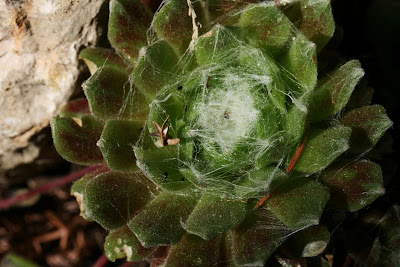S henever I liked rupícolas plants. Beings are adapted to extreme conditions, both in the high mountains and in low latitudes. Comply with minimum ground from which to draw nutrients and endure the cold, sunshine, snow and drought. Moreover, they contribute to the formation of soil between the roots and under the leaves, making it easier for other species to colonize those spaces. I have discussed in other entries on Sedum, who are of the same family and similar habitats, but today I played both to the evergreens.
Just living in a rock cut in a wall or even on rooftops. This last, incidentally, is favored by the belief that under its eaves, protect houses from lightning during storms.
P gender ertenecen Sempervivum, included in the family Crassulaceae.
keep Two species in my garden pebbles are Iberian species, but I've bought the nursery. It's true that I have ever seen in nature, but I've decided to collect them.
Sempervivum tectorum
 The most abundant and easy to maintain. Rosettes are characterized by fairly large compared to other species, and tips of the leaves have a reddish, most of the time.
The most abundant and easy to maintain. Rosettes are characterized by fairly large compared to other species, and tips of the leaves have a reddish, most of the time.  All evergreens produce abundant suckers at its base by stolons, and thus tend to cover the rocks on which they live. Some of these little rosettes are released from the mother plant and can roll and colonize new places. However, they also comes to sexual reproduction and then begins to lengthen the stem ...
All evergreens produce abundant suckers at its base by stolons, and thus tend to cover the rocks on which they live. Some of these little rosettes are released from the mother plant and can roll and colonize new places. However, they also comes to sexual reproduction and then begins to lengthen the stem ...  ... to form a bouquet of flowers. Although the wear suffered by the plant makes the rosette base die finish.
... to form a bouquet of flowers. Although the wear suffered by the plant makes the rosette base die finish.  This species is perhaps the most abundant flowers produced and the more open your bouquet.
This species is perhaps the most abundant flowers produced and the more open your bouquet. 
Sempervivum arachnoideum
 Its name comes from the hairs that cover the leaves, which give the impression that a spider has spun its web over it. While nature is just over an inch of their rosette diameter in specimens of gardening, possibly hybrid, more than double and triple that size.
Its name comes from the hairs that cover the leaves, which give the impression that a spider has spun its web over it. While nature is just over an inch of their rosette diameter in specimens of gardening, possibly hybrid, more than double and triple that size. in nature usually takes acid substrates but in the garden, I put the photos below show that over limestone live without problems. Montana is more than the previous species, but many others can colonize artificial substrates.  The flowers of this species are larger than those of tectorum, but is more compact floral bouquet.
The flowers of this species are larger than those of tectorum, but is more compact floral bouquet.
 As before, the mother rosette eventually die, although that should concern us because then leveraged to grow the sprouts that is around the base.
As before, the mother rosette eventually die, although that should concern us because then leveraged to grow the sprouts that is around the base.
 I think the only way to kill the evergreens is waterlogged base. It seems they are quite likely to be attacked by fungi. Therefore, among rocks and good drainage, but to get wet every day, will take place smoothly.
I think the only way to kill the evergreens is waterlogged base. It seems they are quite likely to be attacked by fungi. Therefore, among rocks and good drainage, but to get wet every day, will take place smoothly.
 The flowers of this species are larger than those of tectorum, but is more compact floral bouquet.
The flowers of this species are larger than those of tectorum, but is more compact floral bouquet.  As before, the mother rosette eventually die, although that should concern us because then leveraged to grow the sprouts that is around the base.
As before, the mother rosette eventually die, although that should concern us because then leveraged to grow the sprouts that is around the base.  I think the only way to kill the evergreens is waterlogged base. It seems they are quite likely to be attacked by fungi. Therefore, among rocks and good drainage, but to get wet every day, will take place smoothly.
I think the only way to kill the evergreens is waterlogged base. It seems they are quite likely to be attacked by fungi. Therefore, among rocks and good drainage, but to get wet every day, will take place smoothly. As I always say, this is not a gardening blog, there are many other places on the Web to find information on the best growing conditions and the many varieties of terrace and garden.
Apart from the varieties grown there are five Iberian species, those above, S. montanum, S. vicentei and S. minutum plus several natural hybrids, apart from other species, S. calcareum , which may be located in the Cantabrian Mountains and in the Pyrenees. Is very similar to S. tectorum but with white flowers-yellow. Its nearest towns are in the South of France.
0 comments:
Post a Comment